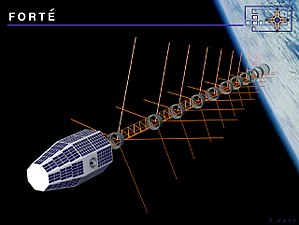cosmos.wikisort.org - Raumschiff
FORTE (auch FORTÉ, Fast On-Orbit Recording von Transient Events) ist ein US-amerikanischer Forschungssatellit. Er detektiert elektromagnetische Pulse, wie sie bei Gewittern, aber auch bei Kernwaffenexplosionen entstehen.
| FORTE | |
|---|---|
 | |
| Typ: | Energieerprobungssatellit |
| Land: | |
| Betreiber: | |
| COSPAR-ID: | 1997-047A |
| Missionsdaten | |
| Masse: | 215 kg |
| Start: | 29. August 1997, 15:02 UTC |
| Startplatz: | Point Arguello Western Air Drop Zone |
| Trägerrakete: | Pegasus XL |
| Status: | aktiv |
| Bahndaten | |
| Umlaufzeit: | 101 min[1] |
| Bahnneigung: | 70° |
| Apogäumshöhe: | 826 km |
| Perigäumshöhe: | 797 km |
Entwicklungsgeschichte
FORTE wurde vom Energieministerium der Vereinigten Staaten finanziert und vom Los Alamos National Laboratory (LANL) und von den Sandia National Laboratories (SNL) entwickelt und gefertigt.[2]
Aufbau
FORTE hatte anspruchsvolle elektronische Geräte zum Erfassen, Analysieren und Aufzeichnen von Strahlen von Radioenergie dabei. Der Satellit benutzte eine vollständig Graphit-Epoxid-Verbundstruktur mit einem Gewicht von nur 41 kg und einer einsetzbare Antenne, die 10 Meter lang war. Es trug drei 2-Achs-Magnetometer und einen Erd-Horizon-Sensor, Impulsrad und 3-Achsen-Magnet-Drehmomentstäbe.
Missionsverlauf
FORTE wurde am 29. August 1997 mit einer Pegasus-XL-Rakete der Orbital Sciences Corporation in einen niedrigen Erdorbit gebracht. Diese Rakete wurde von einer Lockheed L-1011 TriStar in der Point Arguello Western Air Drop Zone vor der kalifornischen Küste abgeworfen. Der Start wurde von der US Air Force durch das Space Test Program finanziert.[2]
Weblinks
- ESA: FORTE (englisch)
- Sandia: FORTE First Satellite to be Controlled From Sandia Labs (englisch)
Einzelnachweise
- Bahndaten nach FORTE. N2YO, 17. Juni 2017, abgerufen am 17. Juni 2017 (englisch).
- ESA: FORTE. In: eoPortal. Abgerufen am 18. Juni 2017 (englisch).
На других языках
- [de] FORTE
[en] FORTE
The Fast On-orbit Rapid Recording of Transient Events (FORTE, occasionally stylized as FORTÉ; COSPAR 1997-047A, SATCAT 24920) is a lightweight satellite[1] which was launched at about 8:30 AM on August 29, 1997[2] into a circular 800-kilometer (500 mi) low Earth orbit which is inclined 70 degrees relative to the Earth's equator,[3] using a Pegasus XL rocket. It was developed and launched by the Los Alamos National Laboratory in cooperation with Sandia National Laboratory, as a testbed for technologies applicable to U.S. nuclear detonation detection systems[2] used to monitor compliance with arms control treaties,[1] and later to study lightning from space.[4] The project was sponsored by the United States Department of Energy, and cost about US$35 million.[1] It utilizes optical sensors, RF sensors, and an "event classifier" in order to make observations, including monitoring Very High Frequency (VHF) lightning emissions in the ionosphere occurring from between 50 to 600 miles (80 to 966 km) above the surface of the Earth, and it will be a component of the VHF Global Lightning and Severe Storm Monitor (V-GLASS) system.[1][3] Its primary mission is to record and analyze bursts of RF energy rising from the surface of the Earth.[1] FORTE is 7-foot (2.1 m) tall, weighs 470-pound (210 kg), and is the first all-composite spacecraft, its framework being made entirely of graphite-reinforced epoxy. It consists of three decks with aluminum honeycomb cores, and composite facing to support the onboard instruments.[1][es] FORTE
FORTE (Fast On-orbit Recording of Transient Events) es un satélite artificial de la USAF lanzado el 29 de agosto de 1997 mediante un cohete Pegasus desde la base aérea de Vandenberg. Tiene como objetivo la detección de estallidos de radiofrecuencia cerca de la superficie de la Tierra como medio de detectar pruebas pruebas nucleares y vigilar el cumplimiento de los tratados de no proliferación nuclear. Incidentalmente también se utiliza para el estudio de las tormentas eléctricas desde el espacio.Другой контент может иметь иную лицензию. Перед использованием материалов сайта WikiSort.org внимательно изучите правила лицензирования конкретных элементов наполнения сайта.
WikiSort.org - проект по пересортировке и дополнению контента Википедии